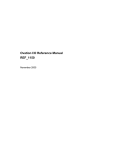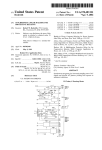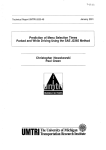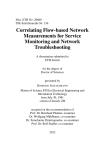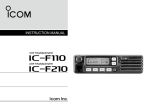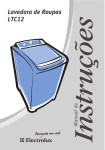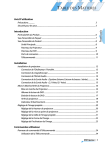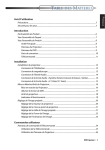Download Power meter for determining parameters of muliphase power lines
Transcript
US005736847A Q Umted States Patent [19] [11] Patent Number: Van Doom et al. [45] [54} [75] Date of Patent: 4,979,122 12/1990 Davis et al. 5,017,360 5/1991 6911119! et al- - LINES 5,059,896 10/1991 Germer et a1. . 5,061,890 10/1991 Langini ................................. .. 324/107 5 981313 1/1992 Yamada et a1‘ ' 5,151,866 9/1992 Glaser 6t =11. ......................... .. 364/487 H. Lightbody; Chuen Shall Simon Ki‘ 51171132311. .......................... .. 324/142 bah of “mm 4'1 °f Canada _ ' ' 5,155,836 Asslglleei CD Power Measurement Llmltei Victoria. Canada . [21] Apr. 7, 1998 POWER METER FOR DETERMINING PARAMETERS OF MULIPHASE POWER Inventors: Peter M. Van Doom, Sidney; Simon [73] 5,736,847 Appl' No" 367534 [22] Filed; Dec 30, 1994 [51] [52] Int. Cl.‘ ................................................. .. G01R 21/133 us. 01. ........................................... .. 324/142; 364/483 [58] Field of Search .............................. .. 324/103 R. 107, 12/1984 Fletcher et a1. . 2/1978 Johnston et a1. . 5/1979 G|j$s _ 4,240,149 12/1980 Fletcher et a1. . 4,345,311 :ggiggi 4’455’612 4:459:546 8/1982 Fielden 6/1993 Wallis .... .. 5,233,538 8/1993 5,243,536 9/1993 Bradford ............................... .. 364/483 Wallis . . . .. . 5,243,537 9/1993 Neumann. 5,245,275 9/1993 Germer eta]. . 324/142 361/93 . 364/483 . . . .. 364/483 $5,531,," U.S. PATENT DOCUMENTS 4,077,061 4,156,230 5,224,054 5,301,121 References Cited Re. 31,774 Jordan et a1. . 5/1993 McEaehern et al. 6/1993 Yalla 61a]. 5,247,454 9/1993 Harrington et 41.. 5,258,704 11/1993 Germ“ 9‘ =1- ~ 324/142, 141, 74; 364/481, 483, 572 [56] 10/1992 5,212,441 5,224,011 4/1994 Garvenich et a1. .................... .. 364/572 5,391,983 2/1995 Lusigman et a1. .................... .. 364/483 5,414,812 5/1995 Filip eta]. . 5,426,780 6/1995 Gerull et a1, . 5,431,700 1/ 1996 Th?misillgh?m 5,498,956 3/1996 Kinney et a1. . _ _ _ Primary Exam/“PW!!! P- Nguyen Attorney Agent, or Firm-Brinks Hofer Gilson & Lione 364/483 [57] 364/433 6/1984 G .s e‘t a] 7,1984 Asa-g:lgmn a '31. ‘ A power meter is discloscd for determining power Paran} eters for power lines having periodic 3-phase voltage and current signals distributed to a plurality of power equipment. ABSTRACT The 3-phase voltage and current signals have a fundamental 4,463,311 7/1984 Kobayashi _ 4 563,934 2/1936 Angood , frequency. The power lines are connected to at least one 4,612,617 911986 Laplace, Jr. et a1. . transducer which generates analog signals representing the 4,642,564 4,663,537 2/1987 Hurley .................................... 324/132 5/ 1937 Mackenzie - voltage and current signals. The power meter includes receiving circuitry which can be connected to the at least one 11:3“ “d313, , rem/e am 364/484 4,783,748 12/1988 11/1988 Harem swam-11166161 a1. .............. .. 364/483 . 4,794,369 4,837,504 transducer to receive the analog signals. An analog to digital ............................ .. 6/1989 Baer etal. ............................ .. 324/142 - - ~ - 09min“ [ECW686216 tgmputl “gm dfmm m: r-eccallvuig conv e vo tage an _ curren s1gn s 0 circuitry an dig‘?! data “fl’fesenung thc,a“a1°g slg'lf‘ls- A Pmccs?“ 4,839,819 6/1989 Begin et aL _ 4,373,142 10/1939 Bergman a ,1_ , 4,878,185 10/1989 Brand et a1. . receives the digital data and includes logo for calculating the power parameters. The power meter compensates for errors caused by not sampling synchronous to the funda 4,884,0Q1 mental frequency of the signals. 11/1989 Hammond et al. ................... .. 324/142 4,901,221 2/1990 Kodosky et a1. . 4,914,568 4/1990 Kodosky et a1. . ‘ 22 Claims, 5 Drawing Sheets US. Patent Apr. 7, 1998 Sheet 1 of 5 5,736,847 FIG. I IOIC \I/ I02A a, - IT: 1026 -'/ LOAD US. Patent Apr. 7, 1998 Sheet 4 of 5 5,736,847 _<3E<<>-$ >.8 TE@§5<2<x3m>;?>= _Hm596.5963c06 US. Patent Apr. 7, 1998 Sheet 5 of 5 5,736,847 FIG. 8 PHASE COMPENSATION CALCULATE kW AND KVAR FIG ' 7 " CALCULATE kVA kvA=(kw2 + kvAR2)'/2 MULTl-POINT CALIBRATION \ CALCULATE B=cos" (kW/kVA) START GIVEN I CALCULATE CALCUE'ATE - q) =0l + bl+ C in) \ MLLTIPLY RAw SIGNAL BY ?l) T0 GET CALIBRATED CALCULATE 9 9=B—¢ SIGNAL ‘ ‘ DONE RECALCLLATE kw AND kVAR kW = kVA 005(9) . kVAR= kVA 51MB) 5 1.736.847 2 1 In addition to monitoring power parameters of a certain POWER METER FOR DETERMINING PARAMETERS OF MULIPHASE POWER LINES load. power monitoring devices have a variety of other applications. For example. power monitoring devices can be used in supervisory control and data acquisition systems (SCADA). process controllers. such as programmable logic controllers (PLC). etc. Therefore. in view of the above. it is the primary objective of the present invention to provide a power monitoring device which can determine the quality of the power ?owing This application is related to U.S. patent application Ser. No. Oil/369.849. now Pat No. 5.650.936 ?led concurrently with this application and entitled “Power Monitor Apparatus And Method With Object Oriented Structure". BACKGROUND OF THE INVENTION 10 The present invention relates generally to digital power monitoring. More speci?cally. the invention relates to a power monitoring device with high accuracy. digital power monitoring system which provides the capa It is still a further object of the present invention to provide a power monitoring device that contains modular components which can be replaced or interchanged. bility to monitor the quality of the power being transmitted through a power system. Monitoring of electrical power. particularly the measuring and calculating of electrical parameters. provides valuable SUMMARY OF THE INVENTION information for power utilities and their customers. Moni toring of electrical power is important to ensure that the electrical power is effectively and e?iciently generated. To achieve these and other objectives. the present inven 20 distributed and utilized. As described in more detail below. odic 3-phase voltage and current signals distributed to a watts. phase relationship between waveforms. KWl-I. is of foremost concern for utilities and industrial power plurality of power equipment. The 3-phase voltage and 25 ates analog signals representing the voltage and current signals. The power meter includes receiving circuitry which Typically. electricity from a utility is fed from a primary substation over a distribution cable to several local substa can be connected to the at least one transducer to receive the 30 analog signals. An analog to digital converter receives the output signal from the receiving circuitry and converts the voltage and current signals to digital data representing the analog signals. A processor receives the digital data and includes logic for calculating the power parameters. The 35 power meter includes means for compensating for errors the distributor cable to the lower voltage at which it is supplied to the end consumer. From the substations. the power is provided to industrial users over a distributed power network which supplies power to various loads. Such loads may be. for example. various power machines. current signals have a fundamental frequency. The power lines are connected to at least one transducer which gener users. tions. At the substations. the supply is transformed by distribution transformers from a relatively high voltage on tion uses innovative hardware and software to monitor the status of the power system. A power meter is disclosed for determining power parameters for power lines having peri knowledge about power parameters such as volts. amps. KVAR. KVARH. KVA. KVAH. power factor. frequency. etc. within a power system. It is a further object of the present invention to provide a caused by not sampling synchronous to the fundamental In such arrangements. utilities need to measure power coming out of or into the generating station or going into a frequency of the signals. power station. It is important to minimize the phase rela tionship between the current and voltage waveforms of the power being transmitted to losses. It is also sample the voltage and current signals in the power system In another aspect of the invention. means are used to as closely as possible to an integral number of times per line frequency cycle. important to minimize the amount of harmonics that are present in the voltage and current waveforms. Also. the ability to detect the presence and magnitude of faults in the power system is important. Thus. accurate measurement of these waveforms is important. In industrial applications. it is important to continuously monitor the voltage. current. phase. harmonics. faults and 3 In another aspect of the invention. means are used to capture transient high current faults in the power system while still maintaining high accuracy when a fault is not 45 Many modi?cations to the preferred embodiment will be apparent to those skilled in the art. It is the intention of this description to provide an example system using the inven phase balance of the power into the machine. These param eters may vary with the machine load. With knowledge of these parameters the industrial user can better adjust. and control the loads to control machines. determine alarm tion. It is not the intention of this description to limit the scope of the invention. BRIEF DESCRIPTION OF THE DRAWINGS conditions and/or to more ef?ciently use the power. Various different arrangements are presently available for monitoring. measuring. and controlling power parameters. 55 Typically. an individual power measuring device which measures speci?c power system parameters is placed on a given branch or line proximate one of the loads. Such power monitoring devices measure electrical power parameters. such as those described above. An example of such a system is disclosed in U.S. Pat. No. 5.151.866. In the system disclosed in this patent. a power analyzer system uses discrete analog transducers to convert AC voltage and current signals from a power system to DC output signals. The values from the voltage and the current present. FIG. 1 schematically represents a preferred embodiment of a system using a power monitoring unit of the present invention. FIG. 2 schematically illustrates a physical layout of a preferred embodiment of a system of the present invention incorporating as components a plurality of power monitor ing units such as shown in FIG. 1. FIG. 3 schematically illustrates a preferred embodiment of the internal structure of a power monitoring unit as shown in FIG. 2. FIG. 4 is a block diagram of an analog interface arrange 65 ment for measuring the fundamental frequency of the volt transducers are then used to calculate the various other age input signal and generating a sampling clock signal desired power parameters. therefrom. 5,736,847 3 4 FIG. 5 illustrates the scenario where the sampling fre quency is exactly an integral multiple of the signal’s fun V3 respectively. The currents I1. I2. and 13 are ampli?ed by two di?erent scales to provide greater dynamic range. The ampli?cation to the two di?erent scales is implemented using the conditioning circuitry 23. Op amps 66A. 66B and damental frequency. FIG. 6 illustrates the scenario where the sampling fre quency is slightly less than an integral multiple of the 66C amplify input current signals 11. I2 and 13. respectively. to a ?rst scale. For example. a current of 5 Amperes AC creates a voltage of 4 Volts AC to the AID converter. Op frequency of the signal’s fundamental frequency. FIG. 7 illustrates a ?ow chart of the logic for calculating the calibration constant. FIG. 8 illustrates a ?ow chart of the logic for calculating amps 68A. 68B and 68C amplify input current signals I1. I2 10 the phase shift compensation. monitor current signals in the normal operating range (with DETAILED DESCRIPTION OF THE PRESENTLY PREFERRED EMBODIMENTS a ?rst scale) and out of normal range currents such as those experienced in transient conditions (with the second scale). The IED 100 includes program logic 88 comprising a means The present invention comprises a novel system and method for monitoring the electrical signals within a power 82 to calculate power parameters and preferably the IED 100 includes logic 88 comprising a means 85 to calculate power system. The novel system is particularly suited to providing highly accurate measurements of these signals and providing means to detect problems within the power system. FIG. 1 schematically illustrates how a power monitoring unit 100 using the present invention is connectable to a three wire power line. Three current transducers (Cl‘s) 102A. 102B and 102C are connected to wires 101A, 101B and 101C of the power line. respectively. Potential transducers (P'I‘s) 104A and 10413 are connected between lines 101A. parameters for signals in the normal operating range and means 86 to calculate power parameters for signals out of the normal operating range. The voltage and current signals enter separate AIDs 29 and 30 so that the voltage and current on a particular phase can be simultaneously sampled. 25 Auxiliary input signals 20 on the AUX board 24 also pass through signal conditioning circuitry 22 and to AID 29. Auxiliary inputs allow the user to sample additional signals in addition to the three-phase voltage and current. For example. the auxiliary inputs may be 0 to 10 Volts DC outputs from a temperature transducer. 1013 and 10113. 101C. respectively. A plurality of fuses 106 are disposed between the lines l01A-101C and PTs 104A and 10413. Fuses 110 are connected between P'Ts 104A and 104B and unit 100. The Cl‘s 102A-102IC are connected through a shorting and I3. respectively to a second scale. For example. a current of 100 Amperes AC creates a voltage of 4 Volts AC to the AID converter. This arrangement permits the IBD 100 to A digital signal processor (DSP) 28 reads the samples 30 switch or test block 108 to the power monitoring unit 100. The CI‘s 102A—102C provide the power monitoring unit 100 from the AID converters 29. 30 through the AID Bus 31. The signals are preferably sampled at the rate of 128 samples per line frequency cycle. The DSP performs a Fast Fourier with current inputs Ill-I32. The FI‘s 104A and 104B Transform (FFT).on the samples to determine the frequency provide the power monitoring unit 100 with voltage inputs V1-V3. Current inputs I41 and I42. chassis ground 112 and voltage input VREF are connected to ground potential. The also calculates Root Mean Square (RMS) voltage and/or current for each input signal. This data is then transferred components of the signal in a manner known in the art. It through dual port RAM 27 to the microcontroller 35. A suitable DSP is a TMS320C25 available from Texas Instru unit 100 is connected to a power supply. such as a standard 120V AC supply. through power leads L and N. FIG. 2 shows a preferred embodiment of the physical layout of a plurality of monitoring units 100 in a system 90 using the present invention. The system comprises one or ments. The Microcontroller 35 performs many functions within the IED. The fundamental frequency to square wave con verter 43 provides a square wave at the fundamental fre more personal computers (PCs) 114 which are used as master devices. A plurality of monitoring units 100 con?g quency of the incoming voltage signals. A suitable funda ured as intelligent electronic devices (IEDs) are used as 45 mental frequency to square wave converter consists of an slave devices. Virtual intelligent electronic devices (VIEDs) LM311D available from National Semiconductor con?g 115 which reside in software on the personal computer 114 ured in a manner known in the art. can also serve as slave devices. All devices in the system are A time processing unit (TPU) within the microcontroller 35 measures this frequency. The TPU also provides the ability to create a signal at a desired frequency. This capa bility is used to create the sample clock for the AID converters. Because the clock within the microcontroller has a ?xed frequency (16.777 MHz), this sample clock has a ?xed minimum resolution. The period of this clock can be interconnected through a communication network 116. The network may be directly connected to devices or may connect through other communications devices such as modems 120. Referring now to FIG. 3. a preferred embodiment of the internal structure of an IED 100 is illustrated. Three-phase voltage and current input signals VI-V3 and I1-I4 from electric power lines enter the motherboard 25 and are converted to voltage levels compatible with the analog to digital converters (Al'Ds) 29 and 30 by signal conditioning circuitry 23. In an exemplary embodiment a suitable AID converter is a 13 bit. 7 input one available from National Semiconductor as model No. LM12458CIV. A suitable voltage to the AID’s 29 and 30 ranges from 0 to 5 Volts depending on what part of the AC signal the sample is taken 55 adjusted to a value that has a resolution of 4 times the microcontroller's clock period. i.e. 238.4216 us. A suitable microcontroller is the MC68332 available from Motorola. Since the DSP is receiving samples from the AID con verters at very close to 128 samples per line frequency cycle. it can perform a Fast Fourier Transform (FFI‘) on any group of 128 consecutive cycles. The result of the FFT is a set of phasors indicating the magnitude and phase of the funda mental frequency of the signal plus the magnitude and phase of the ?rst 63 harmonics. A more detailed description of this at In the illustrated embodiment. the signal conditioning circuitry comprises operational ampli?ers (op amps) and associated circuitry 60. 62 and 64 which amplify V1. V2 and process is given below. Different AUX boards 24 and motherboards 25 can be exchanged with different CPU Boards 46 by using the 5,736,847 5 6 plugable AUX board 24 and motherboard 25. This. however presents a calibration problem and/or a con?guration prob lem. In the system of the present invention. the calibration information and/or con?guration information for the cir cuitry 22. 23 of each AUX or motherboard is preferably stored on the individual board. This is implemented by storing the calibration constants and/or con?guration infor Phasor and Symmetrical Components Calculations In an exemplary embodiment. the present invention samples the 3-phase voltages and currents at 128 samples per cycle. In the exemplary embodiment of the IED 100. the logic 88 includes a phasor calculating means 91 that includes a means 95 to compute voltage and current phasors at each individual harmonic frequency of voltage or current signals such that once a second. the present invention mation in a memory device such as an EEPROM 39. 40 on each individual board. The microcontroller 35 then reads the information using the synchronous serial communications bus 38 before performing calculations on the values received through the dual port RAM 27 from the DSP 28. The synchronous communications bus 38 is also used to 10 computes the phasors for the ?rst 63 harmonics for each signal by performing a l28-point Fast Fourier Transform (FFI') on one cycle of the sampled waveform. The following table can be used to illustrate this opera tion: communicate with the display 51. Results of all calculations and control functions of the microcontroller 35 can be displayed on the display 51. The display 51 provides graphi cal display capability which allows it to display bar graphs indicating the value of a parameter calculated by the micro controller 35. The bar graphs can be updated at a rate of 10 times per second. This provides the user with the ability to see rapid changes in a measured parameter which would be Malwi vb[128] 20 undetectable to the human eye if the parameter value was vc[l28] displayed in numerical format. In addition. the display provides the ability to do the following: 1) display parameter time] values in text format; 2) graph the value of a parameter over time; 3) plot the spectrum of a given voltage or current input M128] in graphical format in a similar fashion to a spectrum analyzer; 4) plot the waveform of a voltage or current input signal in graphical format; and 5) provides self con?guration M128] of its buttons so that the user can customize the display to provide certain information when a certain button is pressed. The synchronous serial communications bus 38 is also used to communicate with the display 51. Results of all calculations and control functions of the micro-controller 35 can be displayed on the display. The IED 100 connects to the network 116 through the communications board 48. The microcontroller 35 sends and receives information from a network over the asynchronous serial communications bus 47. In an exemplary embodiment. in the ED 100 the logic or code is imple mented in ?rmware and in the PC the code is implemented in software. It will. of course. be recognized by those skilled in the art that the logic for the IED 100 can also be implemented in software and that the logic in the PC can be 30 where M641 M641 14641 and currents 35 and Va[64]. Vb[64]. Vc[64]. Ia[64]. 1!:[64]. and Ic[64] are the FF!‘ results (phasors for the dc component and the ?rst 63 harmonics) of their respective waveforms In addition. in the present invention the [ED program logic 88 includes a means 97 for calculating at least one symmetrical component of the voltage and current signals that computes the symmetrical components phasors for the S-phase voltages and currents for the fundamental signal once a second using the following de?nitions: 45 number 28F010 EEPROM. In an exemplary embodiment. the software is written in the C programming language. An exemplary embodiment of the logic for the object oriented architecture of the present invention in object code is given in the micro?che Appendix A provided in the copending application Ser. No. 08/369,849 which is incorporated herein by reference. The object code is presented in Srecord format which is de?ned in the M68332BUG Debug Monitor User’s Manual (Motorola 1990) which is incorporated herein by reference. More detailed schematics for the pres ently preferred embodiment are given in micro?che Appen dix B provided in the copending application Ser. No. 08/369, 849 which is incorporated herein by reference. The [ED logic stored on the EEPROM 34 is rqiresented Vc[64] vall28]. vb[128]. vc[128]. ia[l28]. ib[128]. and ic[128] are the sampled waveforms for the 3-phase voltages implemented in ?rmware. In the present embodiment, the ?rmware is implemented using a ?ash EEPROM 34. such as a 512K byte ?ash EEPROM available from Intel as part W164] new phasor where the operator a causes a counterclockwise rotation through an angle of 120° and is de?ned as a=—0.5t>j0.866. $5 Power Calculations The [ED program logic 88 includes a means 96 for computing real and reactive power at each harmonic fre quency of the voltage and current signals. The real power at each harmonic frequency is computed by multiplying the by the numeral “88” in FIG. 4. A more detailed description of the preferred embodiment of the present invention and its magnitude of the voltage phasor at the harmonic frequency operation is given in US. patent application Ser. No. 08/369. frequency times the cosine of the angle between the two phasors. The reactive power at each harmonic frequency is 849. now Pat. No. 5.65 0936 entitled “Power Monitor Appa ratus and Method with Object Oriented Structure” ?led concurrently with this application, which is incorporated herein by reference. times the magnitude of the current phasor at the harmonic 65 computed by multiplying the magnitude of the voltage phasor at the harmonic frequency times the magnitude of the current phasor at the harmonic frequency times the sine of 5,736,847 7 8 the angle between the two phasors. These two operations can be accomplished for any harmonic of the fundamental frequency up the Nyquist limit. The same result can be that have been taken will span more than n cycles but less than n+1 cycles. This is illustrated in FIG. 5 and FIG. 6. Assuming that the sampling frequency is 16 times (instead of 128 times) the signal’s fundamental frequency. FIG. 5 obtained by multiplying the two phasors together which generates a complex pair representing the real and reactive illustrates the scenario that the sampling frequency is “exactly" 16 times the signal's fundamental frequency. power at the harmonic frequency. while FIG. 6 illustrates the scenario that the sampling frequency is slightly less than 16 times the signal’s funda Tail mental ?'equency. To ensure that the power parameters are calculated over an integral number of line periods. one must determine the number of samples in excess of 11 complete An important aspect of the present invention is the ability to provide high-accuracy power parameters by calculating these power parameters over an integral number of line cycles(the desired integration period) and not include these signal periods. To achieve this. the power monitor includes IED program logic 88 comprising an error compensating samples in the calculations. To achieve this. the IED pro gram logic 88 includes a means 93 for continuously adjust ing the sampling rate to be near synchronous with the voltage and current signals and the following equations are used: means 83 that is able to precisely determine the exact fundamental frequency of the incoming signals. It is rea sonable to assume that the incoming signals V1-V3 and 11-13 have the same fundamental frequency and that this frequency is stable over the measurement period. It is also reasonable to assume that the incoming signals contain signal components of higher harmonics (frequencies that are integer multiples of the fundamental frequency)because of 20 x=ROUND(T the nature of the electrical loads connected t6 the power system. The method of searching for zero-crossings in the sampled data to determine the signal’s frequency is not reliable and is prone to error in the presence of harmonics. In the present invention. the high frequency components in ' the signal are eliminated through the use of a low pass ?lter before attempting to measure the signal’s fundamental fre quency. Referring to FIG. 4. the fundamental frequency to square wave converter 43 receives the phase A voltage signal as input. feeds the signal through a low pass ?lter 60 which has a cuto? frequency “f”. such as of 75 Hz. and generates a square wave output signal whose frequency exactly matches the fundamental frequency of the input signal. The square wave signal is then coupled into one of the TPU channels (TPU14) of the microcontroller 35 con where 25 P,=actual sampling period over 11 cycles x=number of excess samples ROUND()=a function that rounds a number to the nearest integer P,,=accumulated period over n cycles and the excessive samples over n cycles are represented by 30 sample points Sk+1 to Sm_l in FIG. 6. Multi-Point Calibration 35 Non-linear transfer characteristics of the detector and sampling means can be compensated for by the IED pro gram logic 88 including a means 88 for compensating for non-linearity in the receiving circuitry by performing multi ?gured to measure the accumulated period of the input signal over 1 second. The result of this measurement is used point calibration. This results in a calibration constant that is a function of the input signal. The function can be written as follows: to calculate the sample clock period using the following equation: calconstant=f(l)= 45 where For a given input signal I. the calibration constant can be found from K!) and then applied to the .signal. This proce SC=sarnple clock period P,,=accumulated period over 11 cycles measured by TPU14 n=number of cycles Both SC and I’,l are in units of TPU internal clock ticks. dure is shown in the ?ow chart of FIG. 7. 50 and the computation is done using integer arithmetic since fractional clock ticks are not permissible. One of the TPU channels (TPUIS) is then programmed to generate a square wave signal with a period of SC which is transmitted to AID converter 29. This process is repeated every second when power is applied to the power monitoring unit. The sampling clock generated on TPU15 has a frequency of approximately 128 times the fundamental frequency of the input signal. It is important to note that the sampling frequency is. most of the time. not exactly 128 times the fundamental frequency of the input signal because the TPU can only generate a signal whose period is a multiple of the TPU’s internal clock tick (which has a ?nite resolution). As will be appreciated. the division always truncates because of integer arithmetic. One is added-to the result of this division to ensure that SC is always rounded up. This is done to guarantee that at the end of one second. the samples Phase Shift Compensation For an AC system where volts V and current I are given by; 55 v=v, sin (W1) 1=1,, sin (we) (1) (2) Real (kW) and reactive (kVAR) power are proportional to 60 VP*Ip*cos(t-)) and VP*Ip"‘sin(9) respectively. where 6 is the phase angle between the voltage and the current. The phase angle [5 as measured by the meter is the sum of the actual angle 6 between the voltage and current plus an additional phase shift 0 introduced by the detector and sampling 65 means. 5,736,847 10 9 4. The power meter of claim 1 wherein said logic means This additional phase shift ¢ will cause an error in the further comprises: power readings. which must be corrected. To correct for this phase shift it is assumed that the shift introduced by the detector (1) and the sampling means is a function of current L given by; means to compute real and reactive power at each har monic frequency of the voltage and current signals. 5 5. The power meter of claim 1 wherein said logic means further comprises: tpqmrambm means for calculating at least one symmetrical component (4) of the voltage and current signals. 6. The power meter of claim 1 including: conditioning circuitry to receive the voltage and current signals and simultaneously detect signals in a normal operating range The coe?icients ab and c characterize the detector phase shift and are determined at the time of calibration. By de?nition the following applies; and signals in an out of normal operating range; and kVA=(kW’+kVAR’)m (5) kW=kVA cos (a) (6) kVAR=kVA sin (e) (7) Correction of the power readings for the additional phase shift it) is done by the IED program logic 88 including a wherein the logic means further comprises: means to calculate power parameters for the signals in the normal operating range. 7. The power meter of claim 6 wherein the logic means further comprises: means to calculate power parameters for the out of normal 20 means 99 for compensating for a phase shift error using equations (3H7) as shown in FIG. 8. It is also contemplated that the power meter will including processing means to compute the voltage and current sub 25 harmonics. range signal. 8. The device of claim 1 wherein said logic means further comprises means for continuously adjusting the sampling rate to be near synchronous with the voltage and current signals. 9. The power meter of claim 1 wherein at least one of the The foregoing description of the preferred embodiments receiving circuitry and the analog to digital converter intro of the present invention has been presented for purposes of duces a phase shift error and wherein said logic means further comprises: illustration and description. The described embodiments are means to compensate for the phase shift error. 10. The power meter of claim 1 wherein said logic means not intended to be exhaustive or to limit the invention to the precise forms disclosed. Obviously many modifications and variations are possible in light of the above teachings. The further comprises embodiments which were described were chosen in order to means for compensating for non-linearity in the receiving best explain the principles of the invention and its practical applications. It is intended that the scope of the invention be de?ned by the following claims. including all equivalents. I 11. The power meter of claim 1 including a plugable 35 We claim: voltage and current signals and a memory containing cali bration data such that the plugable circuit boards can be interchanged without loss of power meter accuracy. said 1. A power meter for determining power parameters for power lines having periodic 3-phase voltage and current signals distributed to a plurality of power equipment, the 3-phase voltage and current signals having a fundamental frequency, the power lines having connected thereto at least one transducer generating analog signals representing the voltage and current signals. the power meter comprising: receiving circuitry, the receiving circuitry connectable to conditioning circuitry connected to said receiving circuitry. 12. The power meter of claim 1 including a plugable circuit board including condin'oning circuitry receiving said voltage and current signals and a memory containing con ?guration data such that the processor can detect the circuit con?guration and adopt a correct mode of operation, said conditioning circuitry connected to said receiving circuitry. receive the analog signals from the at least one trans 13. A power meter for determining power parameters for ducer and generate an output signal therefrom; an analog to digital converter operatively connected to power lines having periodic 3-phase voltage and current signals distributed to a plurality of power equipment. the receive the output signal from the receiving circuitry, sample said output signal at a sampling rate, and convert the voltage and current signals to digital data power lines having connected thereto at least one transducer 50 generating analog signals representing the voltage and cur rent signals, the power meter comprising: representing the analog signals; and receiving circuitry. the receiving circuitry connectable to a processor operatively connected to receive the digital receive the analog signals from the at least one trans data, the processor including logic means comprising: means for calculating the power parameters; and circuit board including conditioning circuitry receiving said 55 means for compensating for errors caused by not sam ducer and generate an output signal therefrom; an analog to digital converter operatively connected to pling synchronous to the fundamental frequency of receive the output signal from the receiving circuitry. the signals. sample the output signal at a sampling rate. and convert the voltage and current signals to digital data repre 2. The power meter of claim 1 wherein said logic means further comprises: means for calculating at least one phasor of the voltage and current signals. 3. The power meter of claim 2 wherein said calculating means further comprises: means to compute the voltage and current phasors at each individual harmonic frequency of the voltage and cur rent signals. ‘60 senting the analog signals; and a processor operatively connected to receive the digital data, the processor including logic means comprising: means for calculating at least one phasor of the voltage and current signals; and means for continuously adjusting the sampling rate to be near synchronous with the voltage and current signals. 5 ,736,847 12 11 19. The power meter of claim 13 wherein at least one of 14. The power meter of claim 13 wherein said calculating means further comprises means to compute the voltage and current phasors at each individual harmonic frequency of the the receiving circuitry and the analog to digital converter introduces a phase shift error and wherein said logic means further comprises means to compensate for the phase shift voltage and current signals. error. 15. The power meter of claim 13 wherein said calculating 20. The power meter of claim 13 wherein said logic means means further comprises means to compute real and reactive further comprises means for compensating for non-linearity power at each harmonic frequency of the voltage and current in the receiving circuitry. signals. 21. The power meter of claim 13 including a plugable 16. The power meter of claim 13 wherein said calculating means further comprises means for calculating at least one symmetrical component of the voltage and cmrent signals. 17. The power meter of claim 13 including: conditioning circuitry to receive the voltage and current signals and simultaneously detect signals in a normal operating range and signals in an out of normal operating range; and wherein the logic means further comprises means to calculate power parameters for the signals in the nor mal operating range. 18. The power meter of claim 17 wherein the log'c means further comprises means to calculate power parameters for the out of normal range signal. 10 circuit board including conditioning circuitry receiving said voltage and current signals and a memory containing cali bration data such that the plugable circuit boards can be interchanged without loss of power meter accuracy, said conditioning circuitry connected to said receiving circuitry. 22. The power meter of claim 13 including a plugable circuit board including conditioning circuitry receiving input signals and a memory containing con?guration data such that the processor can detect the circuit con?guration and adopt a correct mode of operation. said conditioning circuitry connected to said receiving circuitry. * * * * *













